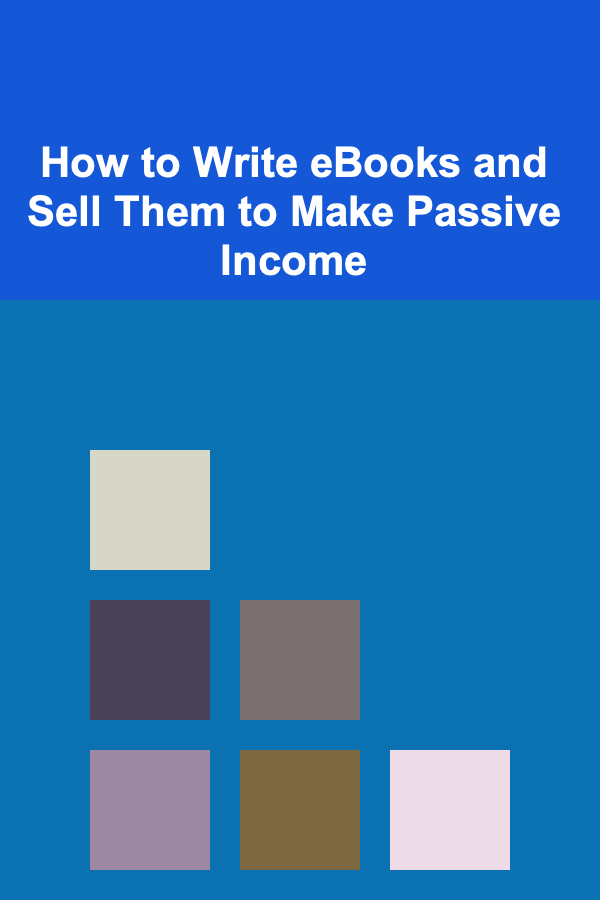
How to Write eBooks and Sell Them to Make Passive Income
ebook include PDF & Audio bundle (Micro Guide)
$12.99$10.99
Limited Time Offer! Order within the next:

Writing and selling eBooks is one of the most rewarding ways to create passive income. With the rise of digital platforms and self-publishing tools, anyone with a valuable idea, skill, or story can turn their knowledge into a profitable eBook. Whether you're an expert in a particular field, a storyteller with a captivating narrative, or someone who just wants to share their experiences, eBooks offer a low-cost, high-reward opportunity to generate income with minimal ongoing effort.
In this actionable guide, we'll explore how to write and sell eBooks effectively to build a steady stream of passive income.
Find Your Niche and Define Your Audience
The foundation of any successful eBook is understanding who you're writing for and what problem you're solving. Before you start writing, you need to ask yourself some important questions:
- What do you know? Think about your expertise. What unique knowledge or experience can you share that others would find valuable?
- What does your audience want? Identify the pain points or needs of your target readers. Are they looking for practical advice, entertainment, or educational content?
- Who are they? Define your ideal reader. Are they young adults, busy professionals, or hobbyists? Understanding your audience will guide your writing style, tone, and the type of content you create.
Researching Market Demand
Before committing to a particular topic, it's important to assess whether there is a market for your eBook. You can conduct research by:
- Checking Popular Platforms: Browse platforms like Amazon Kindle, Apple Books, and Google Books to see what types of eBooks are selling well.
- Analyzing Keywords: Use tools like Google Trends, Kindle Spy, or Ubersuggest to research trending topics and popular keywords in your niche.
- Reading Reviews: Look at the reviews of eBooks in your chosen category. What are people praising? What do they feel is missing?
This research will help you refine your ideas and ensure there is a demand for your eBook.
Plan Your eBook
Planning is crucial to avoid writer's block and ensure that your eBook is well-organized. A strong outline will help you stay on track and break the writing process into manageable sections. Here's how you can approach planning your eBook:
Develop a Strong Concept
Decide what the central theme or core message of your eBook will be. A clear and focused concept is essential to keep your writing on track and avoid diluting your content with irrelevant information.
Create an Outline
An outline is your roadmap for the eBook. It will help you structure your thoughts and present your ideas in a logical flow. A basic outline could look like this:
- Introduction: Explain why the topic is important and how the eBook will help solve a specific problem.
- Main Chapters or Sections: Break down your content into manageable chunks. Each section should focus on a single point or concept.
- Conclusion: Summarize the key takeaways and provide a call to action (CTA), such as encouraging readers to implement the advice or buy related products.
Set a Word Count Goal
eBooks come in various lengths, but it's important to set a word count goal to keep yourself focused. Depending on the topic and depth of content, eBooks typically range from 10,000 to 50,000 words. Setting a goal for each chapter can help prevent procrastination and keep your writing on track.
Write the eBook
Now comes the fun part: writing the eBook. Here are a few tips to help you get started:
Write First, Edit Later
One common mistake new writers make is trying to perfect their writing while they're still drafting. Don't worry about getting everything right on the first try. Just get your ideas on paper, and focus on editing later.
Set a Writing Schedule
Consistency is key when writing an eBook. Set aside dedicated time each day or week for writing, and stick to it. Even if you only write for an hour each day, it adds up over time.
Stay Focused on Your Audience
Keep your target reader in mind as you write. Your writing should speak directly to their needs, desires, and pain points. Whether you're offering practical solutions or storytelling, make sure your writing is engaging and relevant to them.
Make It Easy to Read
eBooks should be easy to read on any device, from smartphones to tablets to eReaders. Use short paragraphs, headings, bullet points, and lists to make the text scannable. Remember to use a friendly and conversational tone if it suits your content---this keeps readers engaged.
Edit and Format Your eBook
Once you've completed your first draft, the next step is editing. This is where your eBook starts to take shape and become a polished product.
Self-Editing
The first step in editing is to review your manuscript for structure, clarity, and flow. Are the chapters logically organized? Does the content flow well from one section to the next? Look for areas where the writing may be unclear or repetitive, and tighten up your language.
Professional Editing
Hiring a professional editor is highly recommended. A professional can help you improve the readability, grammar, and tone of your eBook. They'll also ensure that your eBook is formatted properly for publishing platforms.
Formatting for Different Devices
Your eBook will be read on a variety of devices, so it needs to be formatted properly. Tools like Scrivener, Adobe InDesign, and even Microsoft Word offer templates that are optimized for eBook formatting. Alternatively, you can hire a professional formatter to ensure that your eBook looks good on all platforms.
Design a Compelling Cover
The cover of your eBook is the first thing potential buyers will see, so it needs to make a strong impression. A professional cover can significantly increase the perceived value of your eBook. Here are some key design tips:
- Simplicity is Key: Avoid cluttering your cover with too much text or imagery. A clean, bold design stands out.
- Readable Font: Ensure that your title is easily readable, even at small sizes.
- Visual Appeal: Choose colors and images that align with the theme of your book and appeal to your target audience.
If you're not a graphic designer, it's worth investing in a professional cover designer who specializes in eBook covers. A good cover can boost your eBook's credibility and make it more likely to sell.
Publish Your eBook
Once your eBook is written, edited, and formatted, it's time to publish. There are several platforms available to self-publish eBooks, each with its own set of advantages and limitations. The two most popular options are:
Amazon Kindle Direct Publishing (KDP)
Amazon KDP is the most well-known self-publishing platform. It offers access to Amazon's vast audience, which can be a huge advantage for eBook authors. Here's how to get started with KDP:
- Create a KDP account and upload your eBook.
- Set your price: You can choose between a 35% or 70% royalty option, depending on the price of your eBook.
- Select Kindle Unlimited: You can enroll your book in Kindle Unlimited (KU), Amazon's subscription service, which pays authors based on the number of pages read.
Other Platforms
- Smashwords: Smashwords distributes eBooks to multiple platforms, including Barnes & Noble, Apple Books, and Kobo, which allows you to reach a broader audience.
- Apple Books: If you want to focus on the Apple ecosystem, publishing directly on Apple Books can help you reach readers who prefer iOS devices.
- Draft2Digital: Similar to Smashwords, Draft2Digital is a platform that distributes eBooks to various online retailers.
Pricing and Royalties
When setting a price for your eBook, consider the genre, length, and target audience. Prices typically range from $0.99 to $9.99, but the price should align with the value your eBook provides. A common strategy is to offer your eBook at a lower price initially to attract more readers, then increase the price over time as your book gains traction.
Promote Your eBook
Marketing your eBook is key to generating sales and building passive income. Here are a few strategies to help you promote your eBook effectively:
Leverage Social Media
Social media is a powerful tool for building an audience and driving traffic to your eBook. Create engaging content related to your eBook, such as behind-the-scenes looks at the writing process, reader testimonials, or teaser chapters. Platforms like Instagram, Facebook, and Twitter are great for connecting with your audience.
Build an Email List
Building an email list is one of the most effective ways to nurture relationships with potential readers. Offer a free resource or sample chapter in exchange for email sign-ups. Once you have an email list, send updates about new releases, promotions, or other relevant content.
Reach Out to Influencers
Consider reaching out to bloggers, influencers, or reviewers in your niche to review or promote your eBook. Their endorsement can help you gain credibility and reach a wider audience.
Paid Advertising
If you have a budget, paid advertising can boost your eBook's visibility. Platforms like Facebook, Amazon, and Google Ads allow you to target specific audiences with highly relevant ads.
Conclusion
Writing and selling eBooks can be a lucrative way to earn passive income, but it requires dedication, strategy, and effort. From identifying your niche to crafting high-quality content and marketing your eBook, each step is crucial to building a sustainable income stream.
By following the steps outlined in this guide, you'll be well on your way to writing and selling eBooks that generate consistent passive income.
Reading More From Our Other Websites
- [Home Rental Property 101] How to Handle Security Deposits and Refunds Properly
- [Personal Care Tips 101] How to Use Mouthwash to Combat Teeth Grinding Effects
- [Home Budget Decorating 101] How to Make a DIY Headboard That Fits Any Shoestring Budget
- [Home Space Saving 101] How to Design a Small Living Room That Feels Spacious
- [Organization Tip 101] How to Store Long Chains or Heavy Pieces Safely
- [Personal Care Tips 101] How to Treat Your Cuticles with a Weekly Cuticle Oil Treatment
- [Home Holiday Decoration 101] How to Use Lights to Transform Your Home for the Holidays
- [Digital Decluttering Tip 101] Clean Feed: How to Optimize Your Devices and Apps for a Noise-Free Online Experience
- [Sewing Tip 101] Sewing 101: Essential Stitches Every Beginner Must Master
- [Home Cleaning 101] How to Clean Your Home Without Creating a Mess

How to Care for Your Pet's Coat and Fur at Home
Read More
How to Keep Your Travel Gear Clean and Organized
Read More
How to Share Your Vintage Journey on Social Media
Read More
How to Master Basic Foreign Language Conversation
Read More
How to Create Beautiful Layer Cakes
Read More
10 Tips for Art Exhibition Networking: A Guide for Artists and Enthusiasts
Read MoreOther Products

How to Care for Your Pet's Coat and Fur at Home
Read More
How to Keep Your Travel Gear Clean and Organized
Read More
How to Share Your Vintage Journey on Social Media
Read More
How to Master Basic Foreign Language Conversation
Read More
How to Create Beautiful Layer Cakes
Read More